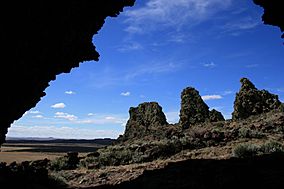Pali-Aike National Park facts for kids
Quick facts for kids Pali-Aike National Park |
|
|---|---|
|
IUCN Category II (National Park)
|
|
 |
|
| Location | Magallanes Region, Chile |
| Nearest city | Punta Arenas |
| Area | 5,030 ha (12,429 acres) |
| Established | October 23, 1970 |
| Visitors | 2,537 (in 2016) |
| Governing body | Corporación Nacional Forestal |
The Pali-Aike National Park is a special place in the Magallanes Region of Patagonia in Chile. Its name, Pali-Aike, comes from the Tehuelche people and means Desolate Place. This park was created in 1970. It covers a large area of 5,030 hectares (12,429 acres), which is about 12,430 acres.
The park is known for its unique landscape, which includes part of the Pali-Aike Volcanic Field. You can see many rocky formations here that are covered in lava from volcanoes that erupted thousands of years ago. The park is also home to native flora (plants) and fauna (animals). Some of these species are found only in this region and nowhere else in the world!
Contents
Discovering Ancient Life in Pali-Aike
Pali-Aike National Park is a very important place for understanding ancient human history. Inside a cave at the Pali Aike Crater, scientists have found human remains from people who lived here a very long time ago.
Stone Tools and Early Hunters
This archaeological site dates back to the Paleo-Indian period. This means people lived here thousands of years ago. The stone tools found in the cave are about 11,000 years old. These tools are some of the oldest ever found in South America!
The Pali Aike cave is very similar to another important site called Fell's cave. Fell's cave is located nearby, just outside the park.
In the 1930s, a scientist named Junius Bird studied the Pali Aike cave. He discovered three human skeletons that had been cremated. This site was likely a temporary camp for early hunters. Scientists also found bones of ancient animals that lived during the Ice Age.
These early people used special hunting tools called 'fluted fishtail points'. These were tips for their darts. They also used other tools, like cylindrical stones, which might have been used for ceremonies. The layers of soil and rock at these sites show that people lived here between 8,600 and 11,000 years ago.
Ancient Art and Diet
You can also find Petroglyphs and rock carvings in the Pali-Aike area. These are drawings or carvings made on rocks by ancient people. They used weathered volcanic rocks from the Pali-Aike volcanic field to make red pigments for their art.
These ancient people hunted many different animals for food. They hunted the mylodon (a type of giant ground sloth), the American horse, guanacos, foxes, pumas, birds, and rodents. They also gathered ostrich eggs. Even though they lived fairly close to the sea, they didn't seem to eat much seafood.
In 1998, the Pali Aike and Fell's Caves were suggested to UNESCO to become World Heritage Sites. This means they are considered very important places for everyone in the world to protect.
Gallery
See also
- Cueva Fell
- Lago Ana
 In Spanish: Parque nacional Pali Aike para niños
In Spanish: Parque nacional Pali Aike para niños





